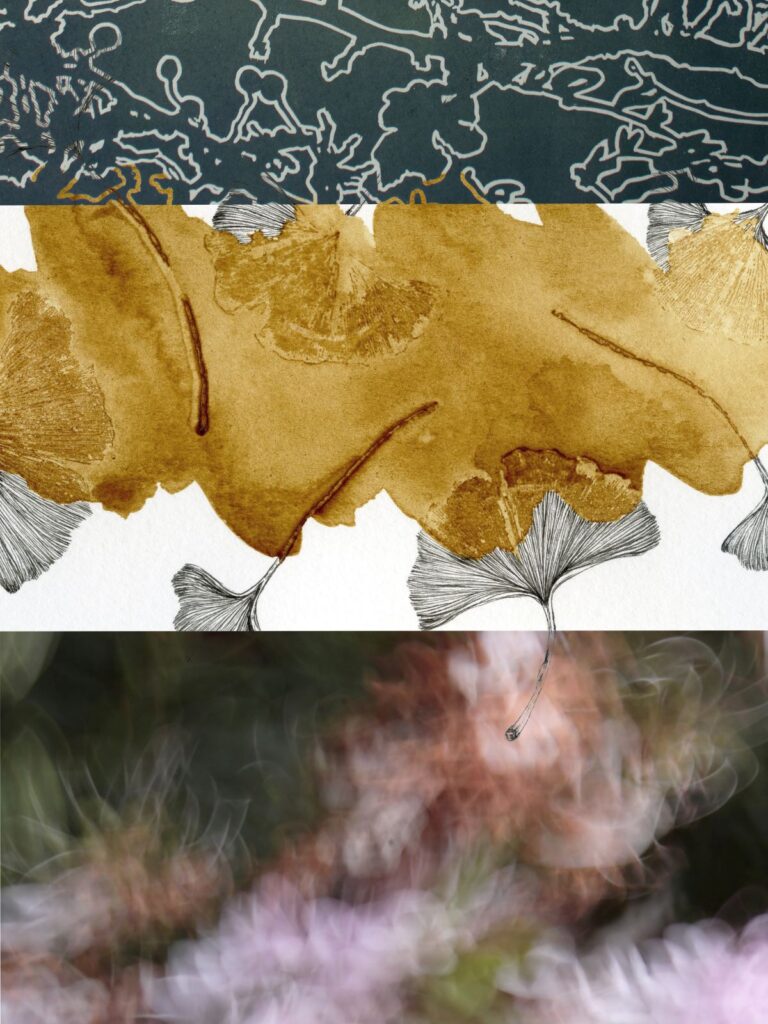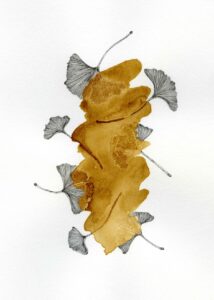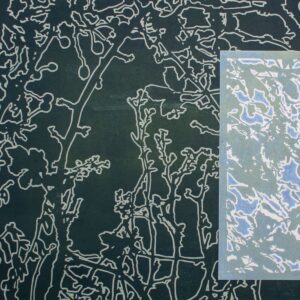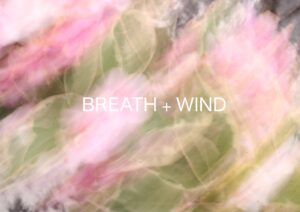Process, Presence, Place

MA in Art & Ecology Exhibition
Maia Hay
Matilda Krulder
Tejasvi Shah
August 15-September 6, 2024
Exhibition Opening: Thursday, August 15, 6-8pm
Opening remarks by Dr. Ruby Wallis
Gallery Hours: 9:30am-5:00pm Monday-Friday
contact@burrencollege.ie
+353 657077200
“Process, Presence, Place” explores the intricate connections between artistic creation, the experience of being, and our relationship with the natural ecology.
Through innovative and thought-provoking bodies of work, the exhibition invites viewers to explore the dynamic processes of nature, the immediacy of being present, and the significance of place in shaping our ecological consciousness.
Each piece serves as a catalyst for reflection on our role within the natural world.
Process, Presence, Place
Opening Remarks by Dr. Ruby Wallis – August 16, 2024
Bramble, bracken, blackthorn, hazel, dog rose, sycamore, ginkgo biloba, wildflowers, domestic flowers, jellyfish, hair oil, Tutsan, Egg Wrack, Bladder Wrack, Serrated Wrack, Channelled wrack, Stinging Nettle, Earth Pigments, Clover Flowers, Beeswax, Recycled Paint.
These are some materials used to create these artworks; these practices involve being sensitive and aware of the artist’s surroundings.
I recently attended a workshop that focused on the importance of being present with each other and in the moment. Key concepts discussed were “noticing” and “attention.” In today’s society, the demands of late capitalism increasingly lead to a disconnect from our surroundings, community, and other people. This can lead to desensitisation, which is concerning, especially considering the fragility of our ecosystem. We must pay mindful and grounded attention to this.
Being attentive to our experiences requires us to slow down. The workshop encouraged us to consider how artistic expressions and aesthetic practices can lead to positive transformation and increased awareness. This process of attention embodies the concept of “care,” of learning to coexist with other species instead of dominating. As suggested by the theorist Donna Haraway in the notion of “making kin.”
The writer Maria Puig Bellacasa sees “care-oriented” modes of thinking as interventions that offer new perspectives and stand against neglect or destruction of care in changing conditions and developments.
In this exhibition, we see the work of three artists working in this field of enquiry:
In Tejasvi’s practice, she photographs flowers blown by the wind, resulting in experimental and phenomenal explosions of colour, flowing in series through delicately sequenced pages of books. This invites us into the intimacy of her quiet experiences with the world. Through her experiments, she soaked the pages of one of the books with hair oil, emitting a beautiful lemony smell and connecting us with the daily life rituals of the artist. This gives the pages extra weight and connects the photograph to the history of oil painting, showing a long-lived entanglement between the two mediums. The words and text are subtly overlaid, not to overshadow or describe the images but to add layers of meaning. We also see the potential of the images in large scale, to experience in a more physical way.
Matilda’s work is focused on a particular site-specific practice. She has cleared and re-energized the Newtown Castle Trail loop, a local pathway. She emphasises path-making, belonging, “slow hand clearing,” and “opening the path to the public.” This participatory and physical process occurred in all weather conditions; the artist was sometimes alone and, at other times, with groups she had invited to participate in from the college and the village. Matilda demonstrates a quiet, persistent determination to explore the area’s potential and a keen attentiveness to the Burren’s local diversity of plant species. The artworks and processes involve collecting plants from the path and using them to create eco prints, silks, and papers. They take on a delicate ephemerality in their material nature, meditative and immersive, attuned to the Japanese woodblock print, in their continuous patterns. Matilda’s practice develops through attention, social engagement, and invitation to participate and connect.
Maia has crafted a remarkable installation using natural pigments and dyes. The prints on display are in the gallery. The large banner-like paintings are the result of letting the materials guide the process, breaking free from narrative and representation. Maia physically attunes through scale, inviting the viewer to engage. The focus is on mark-making and fluidity, creating an energetic and experiential piece. Maia often experiments with waste and recycled materials, centralising human connection and information exchange.
While Maia often works on a large scale as a muralist with a strong social ethos, her small dreamed works offer fragility and intimacy that provide a contrast. She follows the ink, paper, and material as her guide. Like Matilda, Maia is involved in public art and participatory practice, engaging with the community as part of her process. She is creating a mural to extend the exhibition, at the side of the garage in Ballyvaughan.
All of these works synthesise together so well that they generously invite us into a conversation with process, presence, and this unique place. Working with all three artists to realise this exhibition and witness their attention and intention to the ecosystem has been a real honour.
About the Artists
MAIA HAY

Maia Shelby Hay (B. 1998, Greenfield, Massachusetts) is a visual and emerging public artist. After graduating in 2020 with a BA in Visual Art and Political Science from Wheaton College, MA, Maia received a Watson Fellowship. She traveled across Canada, Portugal, South Africa, Serbia, and France studying the impacts of public art post-pandemic and its vital role in communities (2023). Currently completing the MA in Art and Ecology has given her the time and space to weave these experiences into her practice and experiment with alternative processes and waste. Her work reimagines material, emphasizing the significance of natural pigments and the stories they tell, creating a dialogue between the viewer and the environment.
Her research examines the restrictions and accessibility concerns of socially engaged practices aiming to develop new approaches that harness recycled materials and innovative methods to promote alternative forms of creation. Her sculptural work, Beyond the Rain, is on permanent installation at the Franklin Sculpture Park in Franklin, MA, and Wheaton College, Norton, MA.
Website: https://www.maiashelbyhay.com/
Instagram: @hay_its_maia
matilda krulder

My practice is site-specific and aims to develop relationships between people and their more-than-human environments. I am motivated by methodologies of care, maintenance, remembering and belonging. The Newtown Castle Trail historical loop is the site of my current artistic research as I explore creative practice as an essential component of ecological restoration and place-making. I have been maintaining the trail by hand while using printmaking and natural dye methods to enact a conscious engagement with place and make the natural ecology of the trail accessible to walkers. I attempt to learn from existing ways of belonging with place and to create new pathways to restore healthy ecological systems.
tEJASVI SHAH

Tejasvi Shah, born on 13th August 1999 is from Ahmedabad, India. She completed her
Bachelors of Visual Art (BVA- Painting) from The Maharaja Sayajirao University, Vadodara, India
(2021). She then completed her Masters in Fine Art (MFA) from Shiv Nadar University, Delhi
NCR, India (2023) and is currently pursuing her Masters in Art (MA) from The Burren College of
Art, Ireland, in the specialised area of Art and Ecology (2023-2024).
Tejasvi explores ideas of slow viewing and introspection as ways of responding to the increasingly
fast paced, urban world through media such as Photography, Drawing and Text. Ecological thinking
including responding to the space one is in and integrating nature based images from the immediate
natural ecology to build a response, is her area of interest. Images of natural elements such as the
ocean, fossils, flowers, etc are prevalent in her work. She is inspired by artists and photographers
such as Hirushi Sugimoto, Siobhan McDonald and Wolfgang Laib. Tejasvi is currently exploring
methods of making photobooks. Photobooks or sequential images synchronise well with her ideas
as she resonates with images in a continuous series which adds a layer of temporality to her work.
Books allow her to travel back and forth in time at an intimate and a personal level.
Email: tejasvishah99@gmail.com
Instagram handle: tubelight_works
